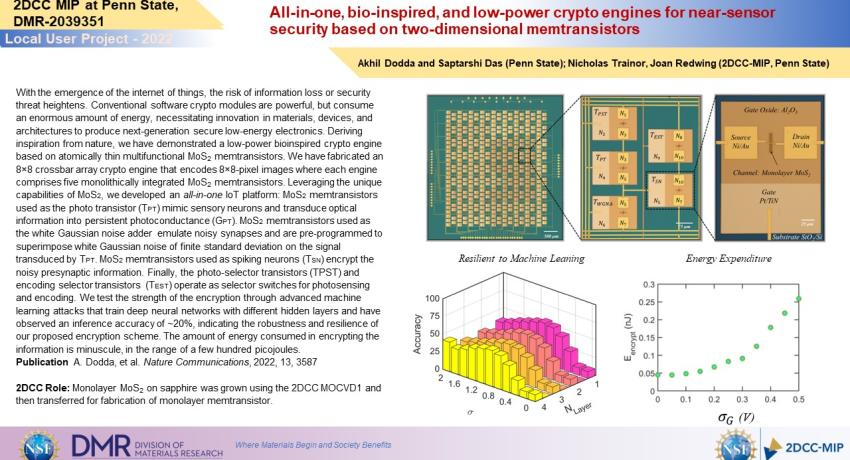With the emergence of the internet of things, the risk of information loss or security threat heightens. Conventional software crypto modules are powerful, but consume an enormous amount of energy, necessitating innovation in materials, devices, and architectures to produce next-generation secure low-energy electronics. Deriving inspiration from nature, we have demonstrated a low-power bioinspired crypto engine based on atomically thin multifunctional MoS2 memtransistors. We have fabricated an 8×8 crossbar array crypto engine that encodes 8×8-pixel images where each engine comprises five monolithically integrated MoS2 memtransistors. Leveraging the unique capabilities of MoS2, we developed an all-in-one IoT platform: MoS2 memtransistors used as the photo transistor (TPT) mimic sensory neurons and transduce optical information into persistent photoconductance (GPT). MoS2 memtransistors used as the white Gaussian noise adder emulate noisy synapses and are pre-programmed to superimpose white Gaussian noise of finite standard deviation on the signal transduced by TPT. MoS2 memtransistors used as spiking neurons (TSN) encrypt the noisy presynaptic information. Finally, the photo-selector transistors (TPST) and encoding selector transistors (TEST) operate as selector switches for photosensing and encoding. We test the strength of the encryption through advanced machine learning attacks that train deep neural networks with different hidden layers and have observed an inference accuracy of ~20%, indicating the robustness and resilience of our proposed encryption scheme. The amount of energy consumed in encrypting the information is minuscule, in the range of a few hundred picojoules.
Publication A. Dodda, et al. Nature Communications, 2022, 13, 3587
2DCC Role: Monolayer MoS2 on sapphire was grown using the 2DCC MOCVD1 and then transferred for fabrication of monolayer memtransistor.
What Has Been Achieved: In this study, we have fabricated an 8 × 8 crossbar array of fully integrated crypto engines consisting of 320 MoS2 memtransistors to sense, store, and encrypt the information sensed by light.
Importance of the Achievement: Through this study for the first time, we were able to monolithically integrate all the essential components of Internet of Things (IoT) that include sensing, storage, computing, and security on a single platform based on monolayer MoS2. This research can assist in developing low power cryptographic primitives for next generation Internet of things (IoT) applications.
Unique Feature(s) of the MIP that Enabled this Achievement: 2DCC-MIP’s MOCVD growth of high-quality, wafer-scale MoS2 films. The growth of high-quality monolayer MoS2 films enabled us to fabricate medium-scale integrated circuits and encrypt the information sensed by light.
Publication: Akhil Dodda, Nicholas Trainor, Joan M Redwing, Saptarshi Das. All-in-one, bio-inspired, and low-power crypto engines for near-sensor security based on two-dimensional memtransistors. Nature Communications 13, 3587 (2022). https://doi.org/10.1038/s41467-022-31148-z.
Acknowledgements: Authors would like to acknowledge Shiva Subbulakshmi Radhakrishnan for his help with the DNN simulation. The work of A.D. and S.D. was partially supported by Army Research Office (ARO) through Contract Number W911NF1920338 and National Science Foundation (NSF) through a CAREER Award under grant no. ECCS-2042154. Authors also acknowledge the materials support from the National Science Foundation (NSF) through the Pennsylvania State University 2D Crystal Consortium–Materials Innovation Platform (2DCCMIP) under NSF cooperative agreement DMR-2039351.
